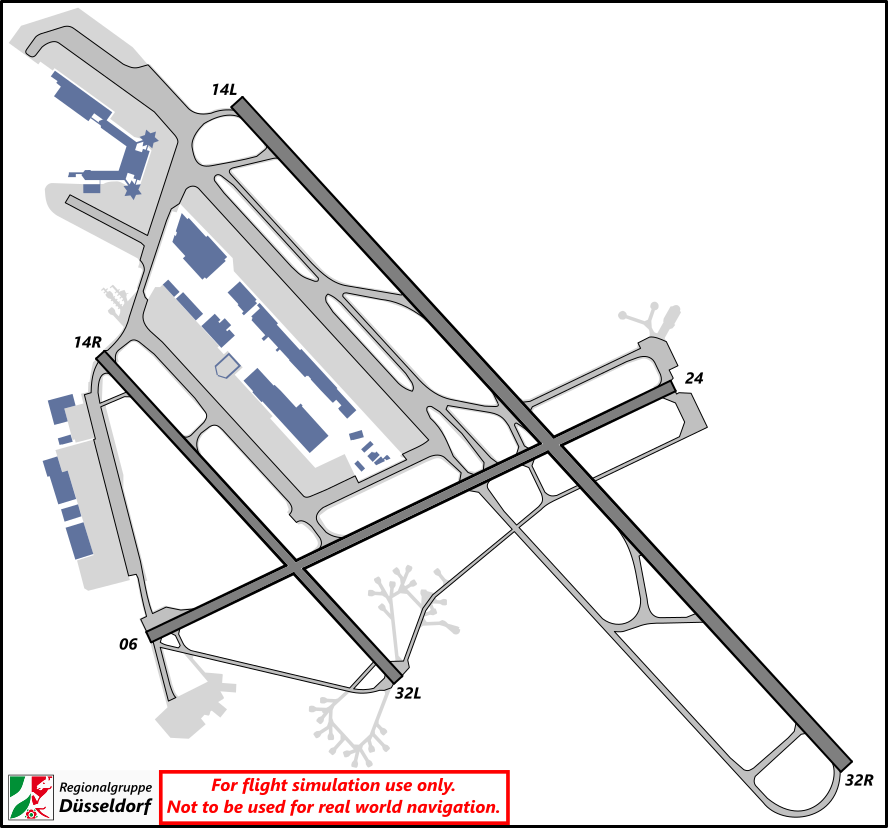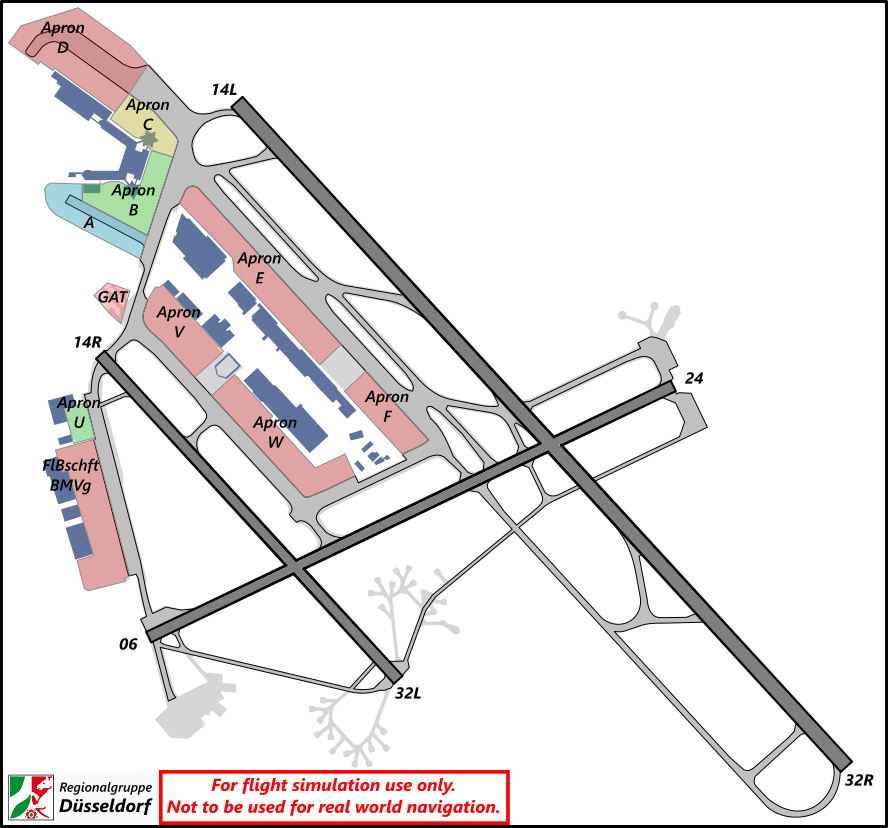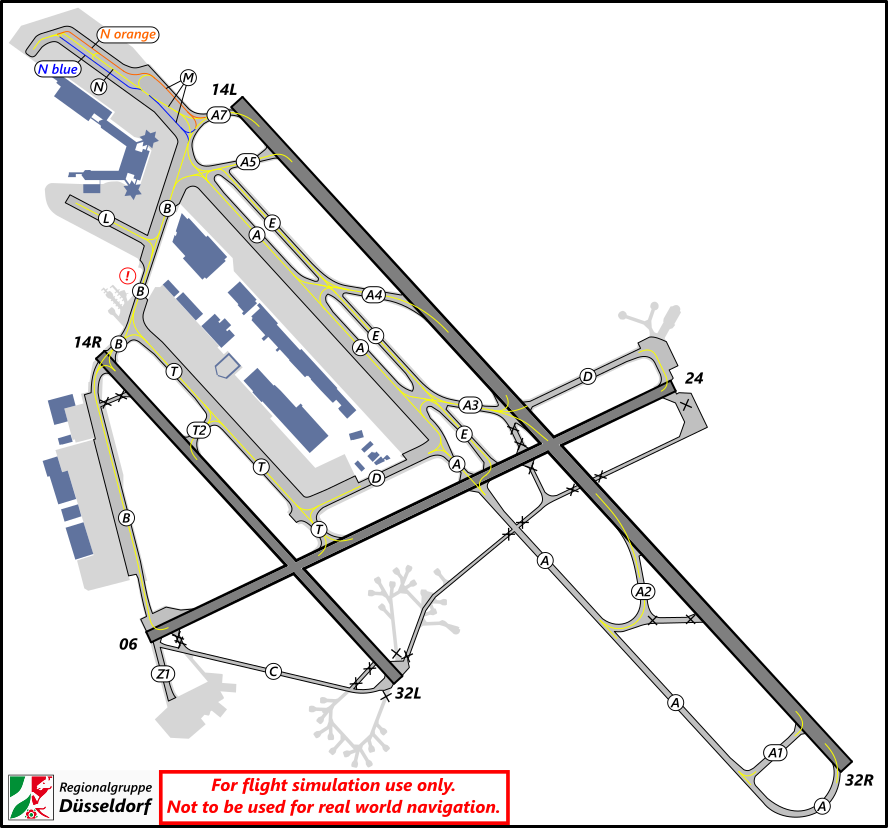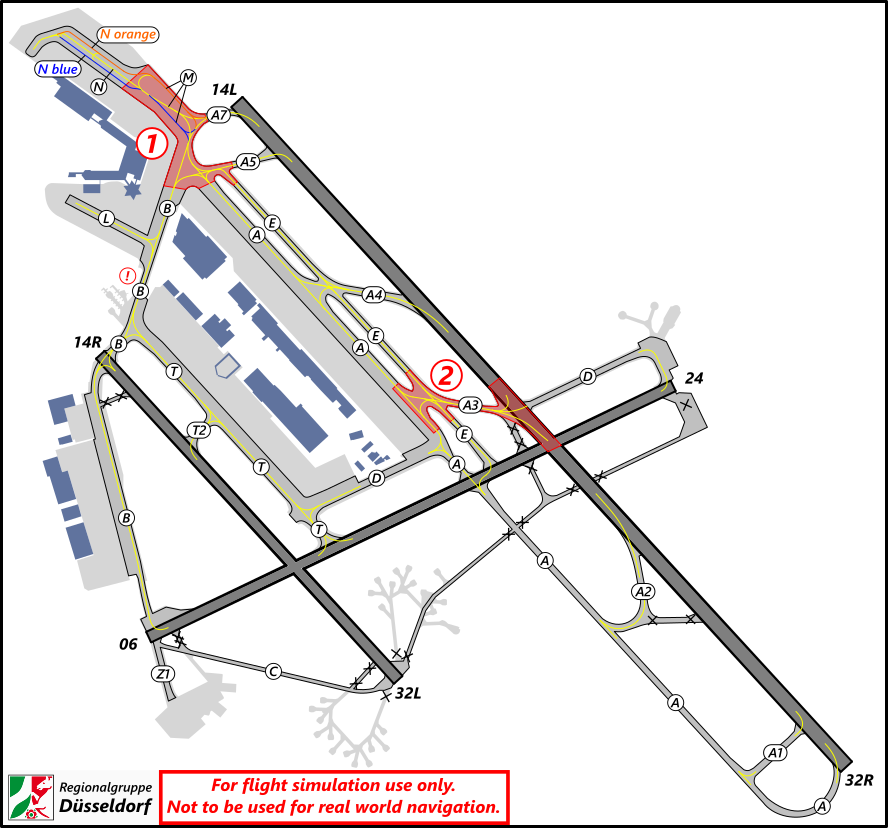Ground
Staffing of Apron (DKGP/EDDK_P_GND) is currently prohibited.
Airport layout
Cologne-Bonn airport has three crossing runways.
The main take-off and landing direction is 32, whereby runway 32R is primary used due to the available length. Business jets or VFR traffic can also use runway 14R/32L for shorter taxi times. During high traffic situations it is recommended to use runway 14L/32R and runway 24 only.
The airport has two passenger terminals. Terminal 1 with its two distinctive stars accommodates aprons A, B and C, and Terminal 2 with the apron area D.
The cargo area is used by several airlines and is located in the middle of the airport between the runways. It contains the apron areas E, F and W.
Apron V close to the cargo area is used for general aviation and business jets.
The military part of the airport is located west of runway 14R/32L13R/31L at apron U. The military part of the apron is the home of the german Flugbereitschaft.
Area of Responsiblility
The area of responsibility of Ground is located between the three runways and includes all aprons except the military apron U (see image below). If RWY 24/06 is closed (not in use), the runway crossing can be delegated to the Ground controller.
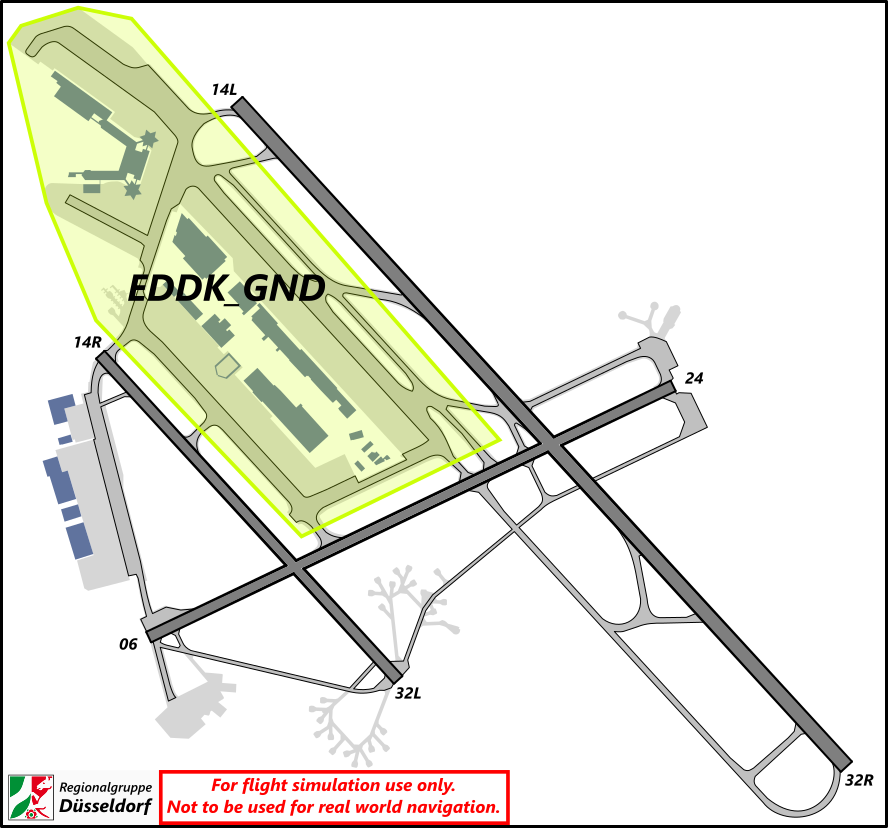 Area of Responsibility - Cologne-Bonn Ground
Area of Responsibility - Cologne-Bonn Ground
Köln-Bonn Apron: Special station that is mainly used for larger events at the airport. It does not have an own area of responsibility and works closely together with Ground. Apron receives the aircraft from Delivery and coordinates with Ground the pushback from the parking positions. For taxi the aircraft are then handed over to Köln Ground.
EWG1TP, pushback approved on the blue line, for taxi contact Ground on 121.730.
Staffing of Apron (DKGP/EDDK_P_GND) is currently prohibited.
Runway Crossing: The crossing of all runways is within the responsibility of Tower, but can be delegated to Ground if the appropriate runway is not in use.
Parking Positions
Parking positions are assigned by the Ground Radar Plugin based on airline and aircrafttyp according real world usage. It is recommended to use the assigned stands. The maximum aircraft size for all parking positions can be displayed in Euroscope (Tower) with shortcut ALT + B.
StandsAprons withA designator- BD: These and Caprons are partthe ofpassenger Terminalterminal 1,aprons. whileAprons Terminal 2 uses designator D. Cargo aircraftA-C are primary parked at stands with designator E, F and W. During the night cargo rush, stands A and V are also used for cargo.Terminal 1, while Apron D is located at Terminal 2.
Aprons E, F, V, W: All of these aprons are home to the big cargo-city at Cologne airport. Most of the heavy lifting cargo fleet (e.g. B747), are parked on aprons E and F, while aprons Vand W are home to the small feeder fleet (e.g. B737, ATR and B757/B767).
Apron U: Apron U is used by two maintenance companies for customers' aircraft. Parking positions U10 - U14 can be used up to code C (A321/B739) and parking positions U16 - U26 only for code A (wingspan < 15m).
Military Apron: The military apron is the apron part west of taxiway B, south of the U stands.
Apron V: Apron V is used for business jets and general aviation. Depending on the position, aircraft up to the size of a B737-BBJ can be parked.
GeneralGAT: aviationThe parking:GAT Thehas no real permanent home. Previously it was located as shown on the map below, northeast of the RWY14R threshold. Nowaday, general aviation is parking mostly on the aprons V and U (partially civil, partially military). The original GAT as shown on the map, is locatedhome northwestto the helipad of taxiwaythe BChristoph between3 rescue helicopter.
Military: Cologne/Bonn is a double purpose airport. While it mostly handles civilian aviation (either pax or cargo), it's also home to the junctionKöln-Wahn Airbase, of taxiwaythe TLuftwaffe. On the western part of the airport (west of 13R/31L), the so called "white fleet" (A350, 340, GLEX) is stationed. To complete the fleet stationed at EDDK, the MRTTs (Multi-Role-Tanker-Transport) A321 and theA330 bridgeare beforealso thelocated junction of stand taxiway L.there.
Antonov AN225 special parking procedure: Parking parallel to taxiway A on Stands E09 to E15, main gear on E12, facing north-west.
Taxiway Usage
The primary used taxiway is A, running parallel to runway 14L/32R.13L/31R.
1431-Operations: Operation:During Landing31-Operations, aircrafttraffic usuallyfrom vacatethe terminals taxiing southbound will be using TWY-A, while inbound traffic vacating the runway viacontinues taxiwayson A3TWY-E, orto A2A5. If there is traffic requesting pushback on the E and areF thenstands, guidedoutbound traffic can be rerouted via taxiwayTWY-E. AHowever, tothis themay parkingbe area.blocking inbound aircraft vacating from RWY 31R.
32 Operation:13-Operations: DepartingDuring aircraft13-operations, areinbound guidedtraffic fromvacating RWY 13L, heading for the terminalterminals, will be taxiing northbound on TWY-A primarily. However, if there is traffic on aprons E and F asking for pushback, the parallel TWY-E can be used as alternative, so that the traffic on those aprons is able to the runway via taxiway A. Landing aircraft usually leave the runway via taxiways A3 or A4 and are then guided towards the terminal via taxiway E.push.
Runway 24/06 for taxi: It is possible for in- and outbound traffic to use runway 06/24 for taxi.
GAF1GH, taxi to holding point runway32R31R via Bravo, enter runway 06 and Alpha, cross runway32L.31L.
DAFHK, taxi right via runway 24 and continue T.
After landing or before takeoff, the word "backtrack" has to be used.
EWG1PC, backtrack runway 24, vacate T.
RYR7AF, backtrack and lineup runway 24.
Taxiway Restrictions
Taxiway B and T can only be used up to Code E aircraft. Taxiway C is limited to Code C aircraft. Taxiway D between A and T can only be used by max. Code E aircraft. The part of D east of runway 14L/32R13L/31R can also be used by a B748.
Parallel taxi on A and E with Code F aircraft: If an Airbus A380 is on taxiway A, taxiway E is limited to Code D aircraft. If a B748 or an AN124 is on taxiway A, taxiway E is limited to Code E (in case of a B748 limited to Code E + B748).
Colored lines: In front of Terminal 2 aircraft up to code C can use the orange and blue line simultaneously up to position D51.
On taxiway B between L and T (marked with (!)) only aircraft with a wingspan of max. 52 m (Code D) and max. weight of 200t are allowed to taxi on it's own. Aircraft up to 234t may be towed over or taxi on their own power over the bridge if guided by a marshaller.
Potential conflicts at the ground
(1)Due Whento usingit's runwaylayout 14Land placement of aprons, there are several critical areas at Cologne/Bonn Airport, which can either lead to congestion or taxi conflicts.
1. The holdingpoint dilemma:
The number one area marked on the map, is the area around the holdingpoint A5/A7, the northern ends of TWYs A and E, as departurewell runway,es GroundTWYs B and M, around the C-Star (Terminal 1). Especially during 13-Ops, this area heavily suffers from congestion. Departing traffic will be queuing mostly at A7, some at A5, while inbound traffic will be taxiing northbound, via TWY A, B and M, to get to Apron D. Possibilities to solve at least some of the congestion issues, will be described on the following pages.
2. A3-Area:
Number two on the map, is the A3-Area. This areas is critical in different scenarios.
- During 31-Operations, A3 is the first suitable highspeed-turnoff for landing traffic. Due to the speed of landing and vacating aircraft, they often fail to stop short off E and continue through to A.
- Another critical situation occurs, in the case of 24-departures. 24-departures need to
takecrosscareRWY 31R at A3. Whenever traffic is instructed to taxi in the direction ofnottheblockingA3 holdingpoint, Ground needs to coordinate with Tower and inform him about thetaxiways B, M, A5traffic, aswellTWRasneeds to inform landing pilots, that A3 is unavailable to vacate theblueRWY.
3. Taxiway B-Bridge
The third critical area is placed on TWY-B. Between Taxilane-L and orangethe lineGAT (marked with departing(!)) taxiway B leads over a bridge where only aircraft forwith inbounda traffic. In high traffic situation outbound traffic might wait shortwingspan of A,max. B52 orm by(Codeletter usingD) theand coloredmax. linesactual untilweight theof inbound200 traffict hasare passedallowed beforeto theytaxi canon continueit's own. A332/A333 and A343 with an actual weight of up to 234 t may be towed or can taxi with a marshaller on ther own power over the holding point.
bridge.
(2)4. IfTaxiway RunwayD
On taxiway D only Code E aircraft and below are allowed, except the part east of runway 13L/31R where also a B748 is used for take-offs, Taxiway A3 may become a bottleneck because aircraft have to be guided to the runway via Taxiways A3 and D, while landing aircraft on Runway 14L/32R could taxi via Taxiway A3.allowed.
Tower should inform landing traffic that taxiway A3 is not available for vacating!

